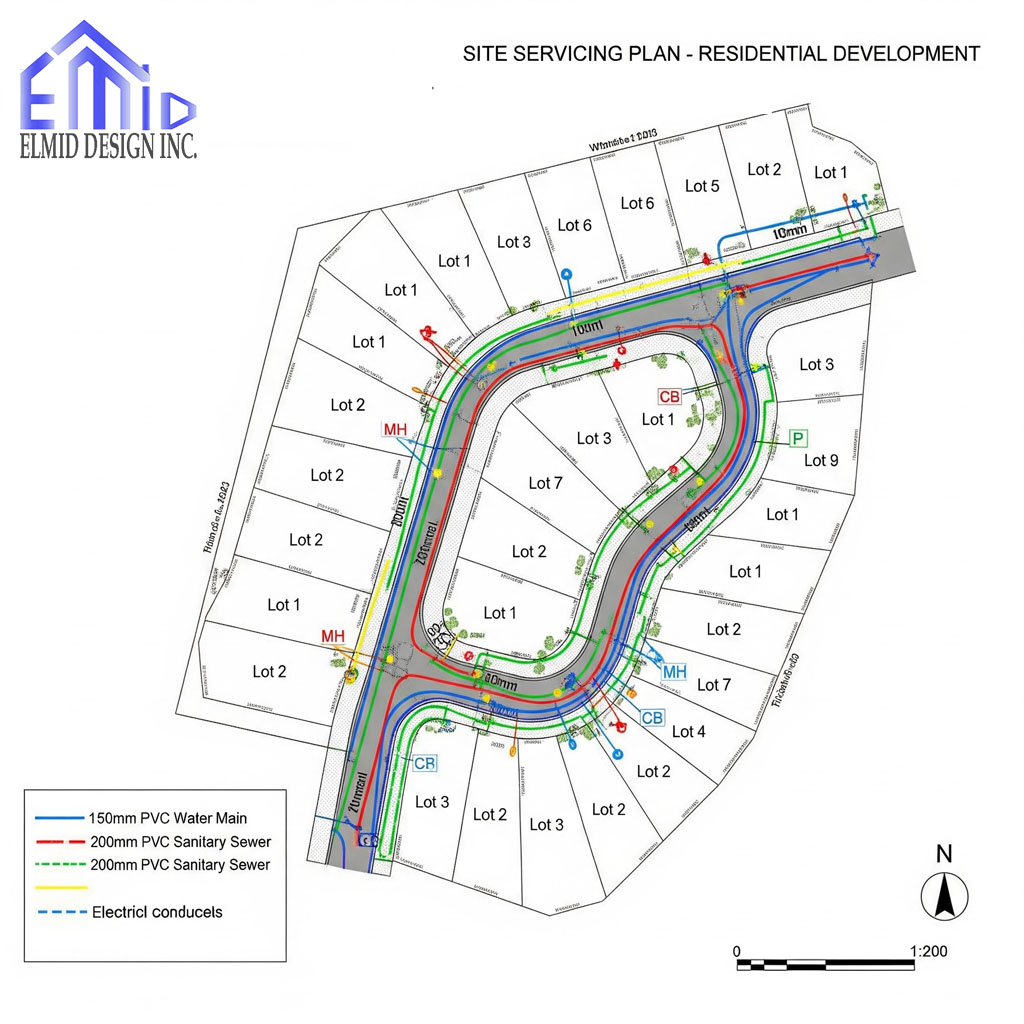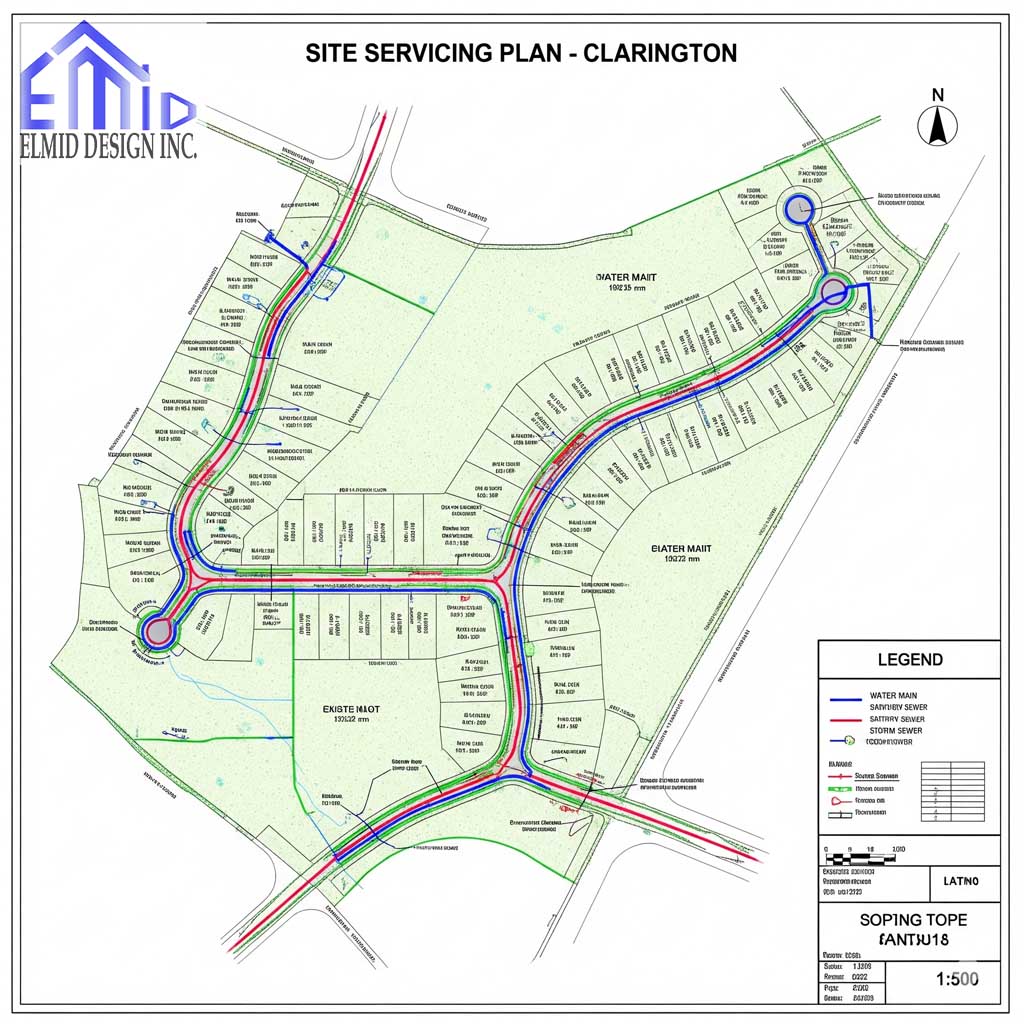A site servicing plan in Clarington is the foundation for any building project because it connects the development to the essential infrastructure that makes the property usable and safe. Developers, homeowners, and businesses all need a site servicing plan to satisfy local requirements, avoid costly mistakes, and ensure compliance with municipal standards. Anyone building in Clarington must understand why this document is essential, how it works, and what must be included. By the end of this guide, you will know the role a site servicing plan plays in construction, the approval process, and why professional engineers like Elmid Design Inc with a certificate of authorization from Professional Engineers Ontario are trusted for such projects.
Key Takeaways
A site servicing plan shows how a property connects to water, sewer, storm drainage, and utilities.
Clarington requires this plan before building approvals can move forward.
Professional engineering involvement ensures compliance with municipal and provincial standards.
A strong servicing plan reduces risk, prevents delays, and protects property value.
What is a Site Servicing Plan in Clarington
A site servicing plan in Clarington is a detailed engineering drawing that demonstrates how the property will connect to municipal services. It outlines water lines, sanitary sewer connections, stormwater management, and grading design. Without this plan, no building project can proceed because it verifies that the proposed development fits with existing infrastructure. For both small residential lots and large commercial projects, the servicing plan is a core requirement. Municipal staff and engineers review it to confirm that the plan meets technical standards and protects both the property and surrounding community.
Why a Site Servicing Plan Matters for Building Projects
Every building project relies on infrastructure. Without safe water supply, sanitary sewer connections, and proper stormwater control, a property cannot function. A site servicing plan matters because it ensures that these services are designed correctly from the start. In Clarington, the municipality requires the plan to guarantee that new development will not strain existing systems. Builders must understand that missing or incomplete servicing details can lead to costly delays. Having the plan approved early reduces risks and helps construction flow smoothly.
Key Components of a Site Servicing Plan
A site servicing plan includes specific engineering details. First, it shows proposed connections for domestic water supply, hydrants, and backflow prevention. Second, it outlines sanitary sewer systems, including pipe alignments, invert elevations, and maintenance access. Third, it demonstrates stormwater drainage through catch basins, manholes, and storm sewers that connect to approved outfalls. Grading plans are also part of servicing because they prevent water from pooling and causing property damage. Utilities such as gas, electricity, and telecommunications may also be shown. Together, these components form a complete package that proves the site is serviceable.
Site Plan Control in Clarington
Clarington applies site plan control to many forms of development. This process requires the submission of a site servicing plan to municipal staff for review. The plan must comply with local engineering design criteria, provincial regulations, and conservation authority guidelines. Site plan control ensures that new developments align with community goals, protect the environment, and provide safe access to infrastructure. For building projects, this step is not optional. It is a mandatory stage in moving from concept to construction.
How Engineers Prepare a Site Servicing Plan
Professional engineers prepare site servicing plans using detailed surveys, base mapping, and design standards. They first assess the existing municipal services to determine available capacity. Then they design proposed connections that comply with standards while minimizing disruption. Engineers also coordinate with utility companies and municipal departments. Grading is calculated using precise elevations to control stormwater flow. The engineer prepares the final plan using CAD software and submits sealed drawings to the municipality. Elmid Design Inc, for example, provides engineering expertise backed by Professional Engineers Ontario authorization, giving assurance that the plan is accurate and reliable.
The Approval Process in Clarington
The approval process for a site servicing plan in Clarington begins with submission to the Planning and Development Department. Municipal engineers review the drawings to ensure compliance with design standards and servicing requirements. If revisions are needed, the engineer updates the plan and resubmits it. Once approved, the plan becomes part of the official site plan agreement. Developers must then construct the services exactly as designed. Any deviations can result in inspection issues or delays. Approval ensures that the municipality accepts the servicing approach and confirms that the property is ready for building permits.
Common Issues That Delay Approval
Delays in servicing plan approval often come from incomplete information, missing details, or non-compliance with design criteria. Incorrect elevations can cause grading conflicts, while undersized pipes may not meet flow requirements. Overlooking utility coordination can also result in rejection. Developers sometimes try to rush the process, but skipping key details leads to longer delays. Using a professional engineering firm reduces these risks because experienced designers understand local standards. By preparing the plan thoroughly from the start, applicants can avoid unnecessary back-and-forth with municipal staff.
Grading and Drainage Considerations
Proper grading and drainage are vital to a site servicing plan. If water does not drain correctly, properties can flood, foundations can crack, and neighbors may be affected. In Clarington, the municipality requires detailed grading plans that show elevations, slopes, and swales. Engineers design these features to direct water safely toward storm sewers or approved outlets. Stormwater management is equally important because it protects waterways and prevents erosion. Without grading and drainage details, a building project cannot move forward because poor design creates long-term liability.
Stormwater Management in Site Servicing Plans
Stormwater management is a central part of site servicing. Every building project increases the amount of impervious surface, which creates runoff. Engineers design storm sewers, detention ponds, or infiltration systems to control flow rates and protect municipal infrastructure. In Clarington, these systems must comply with both municipal guidelines and conservation authority requirements. A well-designed stormwater plan reduces flood risk and protects natural features. Developers who ignore stormwater design often face costly redesigns and municipal resistance, which can delay construction schedules significantly.
Water Supply and Sanitary Servicing
A reliable water supply and sanitary system are non-negotiable for any building project. In a site servicing plan, water design includes connections to municipal mains, fire hydrant placement, and pressure requirements. Sanitary servicing outlines pipe sizes, slopes, and maintenance access. Engineers ensure that the proposed design ties smoothly into municipal systems without overloading capacity. The municipality reviews these elements carefully to guarantee long-term performance. Without approved water and sanitary servicing, no building project can secure occupancy.
Utility Coordination in Clarington
In addition to water and sewer systems, utilities like gas, electricity, and telecommunications must be coordinated. Site servicing plans often show these alignments to prevent conflicts during construction. Utility companies require early consultation to confirm availability and design requirements. In Clarington, developers must coordinate with multiple utility providers and include their approvals in the submission package. Utility conflicts can be expensive to fix once construction begins. By including utilities in the site servicing plan, engineers protect projects from costly surprises.

Environmental Considerations in Site Servicing Plans
Environmental factors play a major role in the design of a site servicing plan. Clarington requires developments to protect natural areas, wetlands, and waterways. Engineers must prepare servicing solutions that control erosion, manage runoff, and reduce contamination. Site servicing often includes low impact development methods such as infiltration trenches or bioswales. These features treat stormwater before it reaches rivers or creeks. By incorporating environmental protection in the servicing plan, developers comply with regulations while improving sustainability.
Developer Responsibilities During the Process
Developers carry responsibility for more than submitting plans. They must hire qualified professionals, pay fees, and coordinate with municipal staff throughout the approval process. Developers are also responsible for financing the construction of servicing works. Once installed, municipal inspectors review the infrastructure to confirm it meets approved standards. Only after acceptance can developers move forward with building permits or occupancy. Understanding these responsibilities helps avoid disputes and keeps the project on schedule.
Cost Factors in Site Servicing
The cost of site servicing varies depending on project size, location, and required infrastructure. Water and sanitary connections can be straightforward for small residential lots but may become complex and expensive for large commercial sites. Stormwater management often adds significant costs, especially when storage facilities or specialized systems are needed. Utility relocation or upgrades can also raise expenses. Engaging engineers early helps developers understand potential costs and budget accurately. Clear servicing designs prevent unexpected overruns once construction begins.
Inspections and Compliance Checks
After the installation of servicing works, inspections are required to ensure compliance. Municipal staff review water, sewer, and storm connections, as well as grading features. If issues are found, contractors must correct them before approval is granted. Compliance checks protect both the municipality and property owners by guaranteeing that infrastructure functions as intended. Skipping inspections or failing to meet standards can delay occupancy permits and create legal liabilities. For this reason, inspections form a critical stage in the servicing process.
The Role of Elmid Design Inc in Site Servicing Plans
Elmid Design Inc plays an important role in the preparation of site servicing plans in Clarington. With a certificate of authorization from Professional Engineers Ontario, the firm provides reliable and compliant designs. Their engineers understand municipal standards and create servicing solutions that satisfy both technical and regulatory requirements. By working with experienced professionals, developers gain assurance that their project will meet approval and proceed without unnecessary delays. Choosing the right engineering partner is essential to avoid costly mistakes.
Site Servicing Plan and Building Permit Connection
A building permit cannot be issued in Clarington without approved servicing plans. The municipality ensures that water, sewer, drainage, and utilities are available before construction begins. This requirement protects both new occupants and the community by preventing unsafe conditions. A servicing plan acts as the technical foundation for the building permit process. Developers who delay in securing approvals often find their entire construction schedule pushed back. Understanding this connection helps builders plan timelines more effectively.
Long-Term Benefits of Proper Site Servicing
Proper site servicing provides benefits long after construction ends. Homes and businesses with reliable infrastructure are more valuable and less prone to maintenance problems. Correct grading prevents flooding, while strong stormwater systems protect both properties and the environment. Communities also benefit when developments follow proper servicing standards because municipal systems remain balanced and functional. Investing in high quality servicing at the start reduces costs for owners and the municipality over the life of the property.
Risks of Skipping Professional Involvement
Some developers may attempt to reduce costs by avoiding professional engineering services. This decision almost always results in delays, rejected plans, or costly errors. Without a licensed engineer, servicing plans lack the seal required for approval. Improper designs can cause failures that damage property or disrupt municipal systems. In Clarington, the municipality relies on engineers to provide accountability and technical accuracy. By involving professionals like Elmid Design Inc, developers protect themselves from unnecessary risks and liabilities.
Future Growth in Clarington and Servicing Needs
Clarington continues to grow as new residential and commercial developments expand across the region. This growth places pressure on municipal services and increases the importance of site servicing plans. Future projects will require careful coordination with the municipality to ensure infrastructure can support new demand. Developers must expect stricter regulations and higher technical standards as growth continues. Proper servicing plans will remain central to sustainable building and responsible community expansion.
Final Approval and Project Handover
Final approval of a site servicing plan marks the transition from design to construction and occupancy. Once municipal staff confirm that services are installed according to approved plans, the municipality assumes responsibility for public infrastructure. Private developers retain responsibility for maintenance of on-site systems. This final handover closes the approval process and allows the building project to move forward fully. Achieving this step requires accuracy, compliance, and close cooperation between engineers, contractors, and municipal officials.
Case Studies of Site Servicing in Clarington
Examining real projects highlights the importance of proper servicing design. In residential subdivisions, engineers must design water and sewer systems that support dozens of homes while meeting fire protection standards. In commercial developments, stormwater detention ponds and utility relocations often form major parts of the servicing plan. Each project demonstrates how detailed planning avoids construction delays and ensures compliance. These examples confirm that servicing plans are not only technical drawings but also practical tools that protect investments.
Comparing Clarington with Other Municipalities
Clarington applies strict servicing requirements, similar to other municipalities in Ontario, yet with unique local standards. Larger cities may require additional environmental reviews, while smaller towns sometimes have less capacity in existing infrastructure. By comparison, Clarington balances development goals with sustainable growth. Developers who have worked in multiple regions often find Clarington’s process thorough but fair. Understanding these differences allows builders to prepare better and reduces friction when transitioning projects between municipalities.
Integration of Servicing Plans into Building Process
A servicing plan is not separate from construction but integrated into every stage. Builders rely on it when setting elevations, installing underground services, and coordinating trades. Inspectors use it to verify that construction follows municipal approvals. Once the building rises above ground, servicing still matters because grading, drainage, and utilities must align with the plan. Without this integration, projects risk misalignment that can be costly to fix. Servicing plans remain active documents from start to finish of construction.
Importance of Early Consultation with the Municipality
Early consultation with municipal staff prevents problems before they occur. In Clarington, pre-consultation meetings allow developers to confirm requirements and identify constraints. By engaging early, engineers can design servicing solutions that align with municipal expectations. This proactive approach saves time and avoids rejection during formal review. Delaying consultation often leads to redesigns, wasted resources, and project setbacks. Developers who build strong communication with municipal staff experience smoother approvals and faster progress.
Role of Conservation Authorities in Servicing Approval
Conservation authorities oversee natural features and environmental protection in Clarington. Their approval may be required if a development affects wetlands, rivers, or floodplains. Engineers must demonstrate that servicing plans do not harm sensitive areas. Stormwater controls, erosion protection, and buffer zones are common requirements. Working with conservation authorities adds complexity but ensures that development proceeds responsibly. Ignoring these requirements can halt a project entirely. Proper engagement with conservation authorities strengthens the quality of servicing plans.
Site Servicing and Sustainable Building Practices
Sustainable building requires more than efficient structures. It begins with infrastructure that supports environmental protection. Servicing plans in Clarington increasingly integrate green infrastructure techniques such as permeable surfaces, rain gardens, and infiltration systems. These measures reduce runoff and recharge groundwater. Sustainable servicing reduces long-term municipal costs and enhances community resilience. Developers who embrace sustainable servicing contribute to a healthier environment while also meeting growing regulatory demands. The connection between sustainability and servicing is becoming stronger every year.
Future Trends in Site Servicing for Clarington
Future servicing plans in Clarington will adapt to changing technologies and environmental standards. Digital modeling tools will allow engineers to test multiple scenarios before construction. Smart infrastructure may integrate sensors to monitor water use, sewer flows, and stormwater capacity in real time. As urban growth continues, servicing will focus on balancing development with environmental stewardship. Developers who anticipate these trends will gain a competitive advantage because they can adapt designs quickly and meet new expectations.
Community Benefits of Strong Servicing Standards
Strong servicing standards benefit not only developers but also the entire community. Reliable water and sewer systems protect public health. Effective stormwater controls reduce flooding and safeguard natural habitats. Proper grading ensures safer neighborhoods and longer lasting infrastructure. These benefits create stronger property values and healthier living conditions. Communities that prioritize high quality servicing enjoy smoother growth and fewer long-term issues. Clarington’s commitment to these standards reflects its dedication to sustainable development.
Challenges Faced by Developers in Servicing Plans
Developers face challenges when preparing servicing plans, including cost, time, and regulatory complexity. Coordinating multiple utilities can delay submissions. Environmental constraints often require redesigns that add expense. Municipal review timelines sometimes stretch longer than expected. Despite these challenges, developers cannot avoid servicing requirements. Instead, they must approach them strategically by hiring skilled engineers and engaging early with authorities. By recognizing challenges early, developers can reduce risks and maintain project momentum.
Final Thoughts on Site Servicing Plans in Clarington
Site servicing plans form the backbone of every building project in Clarington. They connect developments to critical infrastructure, protect the environment, and secure municipal approval. Developers, engineers, and municipal staff work together to produce plans that balance growth with sustainability. Firms like Elmid Design Inc provide trusted expertise that ensures compliance and efficiency. As Clarington continues to expand, servicing plans will remain central to safe and responsible development. For anyone planning to build, understanding servicing is not optional but essential.
Frequently Asked Questions
What is included in a site servicing plan in Clarington
A site servicing plan includes water connections, sanitary sewer systems, stormwater management, grading, and utilities.
Why is a site servicing plan required before building permits
The plan proves that infrastructure can support the development and ensures safety for future occupants.
Who prepares a site servicing plan in Clarington
Licensed professional engineers prepare the plan, and their seal is mandatory for municipal approval.
How long does site servicing approval take in Clarington
Timelines vary but usually require several rounds of review and revision depending on complexity.
What happens if servicing is not built as designed
If servicing does not match approved plans, the municipality can withhold permits or require costly corrections.

Elmid Design Inc: Trusted Engineers for Site Servicing in Clarington
Elmid Design Inc is a professional engineering firm with a certificate of authorization from Professional Engineers Ontario, specializing in site servicing plans for building projects in Clarington. The company delivers accurate, compliant, and efficient designs that meet municipal standards while supporting sustainable growth. With a strong reputation for expertise and reliability, Elmid Design Inc helps developers and property owners secure approvals faster and avoid costly delays. Their engineering solutions provide the foundation for safe, successful, and long-lasting construction projects.
Geographic Locations That We Service:
Our Licensed Professional Engineers specializing in Engineered Site Grading Plans offer the best-engineered site grading plan, lot grading and erosion plan, and drainage plan to obtain site plan approval and building permits in Ontario, including a wide range of municipalities. Each area boasts unique features and requirements, making our tailored approach essential for success.
Toronto and Surrounding Areas
In the vibrant heart of Ontario, we service Toronto (City of Toronto) and surrounding areas. Additionally, we cover Oshawa (City of Oshawa), Pickering (City of Pickering), and Clarington (Municipality of Clarington). Furthermore, our expertise extends to Ajax (Town of Ajax), Whitby (Town of Whitby), Brock (Township of Brock), Scugog (Township of Scugog), and Uxbridge (Township of Uxbridge).
Halton Region
Moving to the Halton Region, our services encompass Burlington (City of Burlington) and Halton Hills (Town of Halton Hills). Also included are Milton (Town of Milton) and Oakville (Town of Oakville).
Peel Region
In the Peel Region, we provide services in Brampton (City of Brampton), Mississauga (City of Mississauga), and Caledon (Town of Caledon).
York Region
Our services in the York Region cover Vaughan (City of Vaughan), Aurora (Town of Aurora), and East Gwillimbury (Town of East Gwillimbury). We also cater to Georgina (Town of Georgina), Markham (City of Markham), Newmarket (Town of Newmarket), Richmond Hill (City of Richmond Hill), Whitchurch-Stouffville (Town of Whitchurch-Stouffville), King (Township of King), and Bradford-West Gwillimbury (Town of Bradford-West Gwillimbury). Each municipality here offers a distinct setting, requiring our specialized approach.
Other Southern Ontario Cities and Towns
We also serve many other cities and towns in Southern Ontario. These include Hamilton (City of Hamilton), St. Catharines (City of St. Catharines), Niagara on the Lake (Town of Niagara on the Lake), Brant (County of Brant), Cambridge (City of Cambridge), Kitchener (City of Kitchener), Waterloo (City of Waterloo), and Woodstock (City of Woodstock). Furthermore, we operate in Guelph (City of Guelph), Centre Wellington (Township of Centre Wellington), Shelburne (Town of Shelburne), Orangeville (Town of Orangeville), New Tecumseth (Town of New Tecumseth), Essa (Town of Essa), Collingwood (Town of Collingwood), Wasaga Beach (Town of Wasaga Beach), Barrie (City of Barrie), Midland (Town of Midland), Orillia (City of Orillia), Ramara (Town of Ramara), Minden Hills (Town of Minden Hills), North Kawartha (Town of North Kawartha), Kawartha Lakes (City of Kawartha Lakes), Peterborough (City of Peterborough), Selwyn (Town of Selwyn), and Brighton (Municipality of Brighton).




